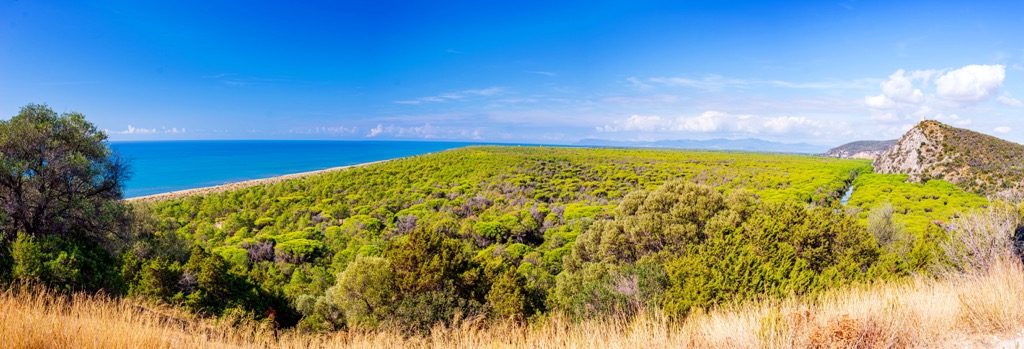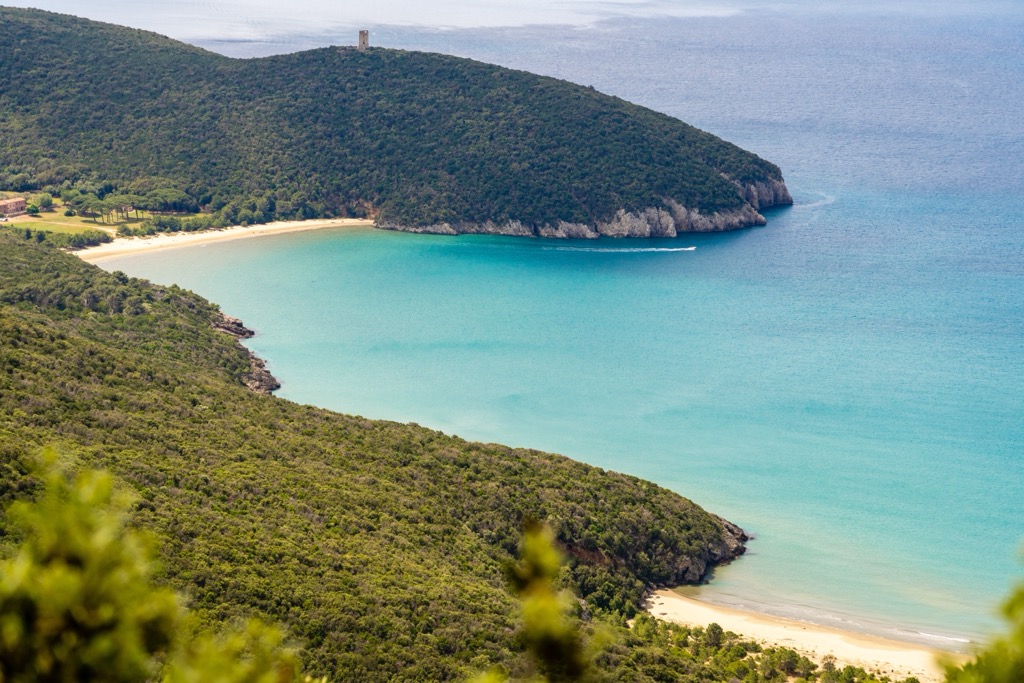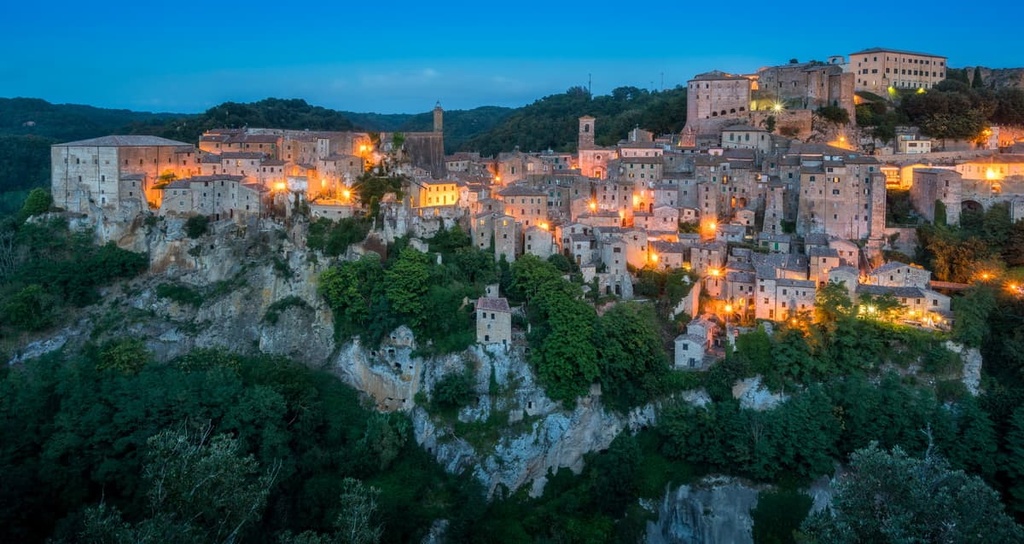Get PeakVisor App
Sign In
Search by GPS coordinates
- Latitude
- ° ' ''
- Longitude
- ° ' ''
- Units of Length

Yes
Cancel
Share ×

Scan the QR code and open PeakVisor on your phone
❤ Wishlist ×
Choose
Delete
From forest-covered hills to crystal clear sea, Maremma Regional Park (Parco Naturale della Maremma) in Italy offers hikers a mix of nature and history. There are 26 named mountains in Parco Naturale della Maremma. The highest and most prominent mountain is Poggio Lecci.

Established in 1975, Maremma Regional Park covers 90 sq. km (35 sq. mi) of protected area. The park is set in Tuscany in the province of Grosseto and spans the municipalities of Grosseto, Magliano in Toscana, and Orbetello.
Maremma Regional Park is set on Tuscany’s coast and runs 30 km (18 mi) along the Tyrrhenian coast from Principina a Mare to Talamone. The park incorporates the last stretch of the Ombrone river, the orographic system of the Uccellina mountains, the Trappola marshland, and the sandy beaches and cliffs of the coast.

To the north of the Ombrone river, the landscape is dominated by a plain. To the left of the river’s mouth, the area is defined by a compact system of dunes alternating with marshy ground. The area is crossed by artificial canals which date back to the eighteenth century.
The central and southern areas of the park are dominated by the Uccellina mountains, which bear witness to past human presence in the form of religious towers and buildings such as San Rabano Abbey.
Maremma Regional Park is home to the Uccellina mountains, a group of hills made up of a mix of calcareous and siliceous rock. These hills divide the Ombrone plain from the Albegna plain and are almost entirely covered in thick forest vegetation. Only the lower parts have been deforested and transformed into pastures or olive groves.

There are 20 known caves in the park, some of which are archeological sites: Grotta dello Scoglietto, Grotta della Fabbrica and Grotta spaccasasso.
The highest point in the Uccellina mountains is Poggi Lecci, at a humble 414 m (1,358 ft) of elevation.

Several ecosystems coexist in Parco della Maremma, creating an interesting mix of biodiversity. From thick pine forests to the rich wetlands of the Trappola marshes, the park has numerous different landscapes to enjoy.
The Ombrone is the main river, however, there is also a dense network of streams due to the reclamation of the plains. The coastline is comprised of sandy beaches and wide dunes, which alternate with steep cliffs and small bays. Flora in this sandy area includes milkweed, opposite-leaved saltwort, and sand dropseed.
The area close to the coast is populated by domestic pines, maritime pines, junipers, European marram grass, Medicago marina, sea chamomile, sea daffodil, and Eryngos. The Grand Duchy pine wood covers 6 sq. km (2 sq. mi) in the Marina di Alberese plain, spanning the area between the Ombrone river, the sea, and the slopes of the Uccellina mountains.

The Uccellina mountains are covered by dense woodlands, such as Mediterranean Marquis and oaks, and other Mediterranean species such as evergreen oak, strawberry tree, mastic tree, common myrtle, mock privet, heather, cork oak, and downy oak, amongst others. You can sometimes spot buzzards, kestrels, and short-toed eagles circling in these environments.
The park’s wetlands cover 7 sq. km (3 sq. mi) and lie near the mouth of the Ombrone river and around the Trappola marsh. These are part salt water and part fresh water. This part of the park is protected and bears witness to when ponds, marshes, and swamps once dominated the landscape of Maremma.
Typical species in the marsh include Rushes and reeds, Sedges, and Bulrush. Where the concentration of salt water is higher, the Thorny Reed and the Marsh Reed give way to the Maritime Reed, the Black Reed, the Sea Buckthorn, and the Sea Wormwood.
Fauna in the wetlands includes Invertebrates and amphibians such as the Green Frog, the Great Crested Newt, the Spotted Newt, and reptiles such as the Collared Newt and Water Tortoises.

The wetlands are also rich in birdlife, with around 270 species. They represent an important stop along migratory routes, species to look out for include osprey, marsh harrier the great curlew, plover, redshank, little sandpiper, common sandpiper, herring gull, flamingos, cranes, and numerous species of ducks and lapwings.
Agricultural areas are widespread in the park with cultivated fields, vineyards, fruit trees, olive groves, and pastures. In particular, the Piana dei Cavalleggeri and Piana della Caprarecce and other large grasslands are where the Maremmana cows graze.
Several different mammals populate all areas of the park. These include wild boar, roe deer, fallow deer, fox, badger, stone marten, porcupine, and hare.

Human history in Parco della Maremma dates back to prehistoric times, with many findings in the park’s caves. There are also numerous Roman settlement remains, as well as medieval watchtowers.
The Etruscans claimed the land before conceding to the Romans, who were interested in the area thanks to its rich mineral content, thermal springs, and access to the sea.
During the Middle Ages, the area was divided between the noble families of Aldobrandeschi and Orsini, until the province was torn apart by the Spanish and Sienese. The Maremma then fell slowly into decline. Swampland and coastal marshes began to cover the fertile land, and without dams, rivers flooded the woods. Malaria was rife during this time.
Maremma was eventually used for winter grazing for cattle herds from the Apennines, despite reclamation efforts by the grand dukes of Tuscany in the eighteenth and nineteenth centuries.

In the 1930s, Mussolini’s government began the reclamation of the area by draining the swamps and culminated in the 1950s with the Maremma Land Reform Agency, which changed the face of the area by adding roads and farms.
The area is also rich in minerals such as pyrite, iron, mercury, and antimony. There were once mines close to the park in the Colline Metallifere area, where you can find museums that illustrate how the area was used during the industrial age of the nineteenth and twentieth centuries. You can even visit the ex-Ravi-Marchi mine, an open-air site dominated by tall, rusty iron towers, and gradually encroached upon by nature.

More recently, agricultural activity characterizes the area, with cultivated fields, vineyards, olive groves, and pastures where herds of Maremmana cattle graze. These herds are one of the two breeds well-known for producing the famed Fiorentina steak. The cattle are listed on the Slow Food Ark of Taste, which preserves at-risk food that is produced sustainably, is part of a distinct ecoregion, and is maintained by the global Slow Food movement.
Maremma Regional Park has created a collective quality mark used by companies that meet the requirements. This quality seal is present on many products within the protected area and ranges from dairy production to fruits and vegetables, honey, oil, wine, beer, pasta, and so on. These products are found on the farms or in the local shops and restaurants.
Maremma’s economy derives mainly from agriculture and tourism, and fishing still represents one of the local traditional activities along the coast. The area is the perfect destination for anyone wanting to experience nature, sports, good food, wine, and the beach!

There are several hikes to enjoy the park’s rich biodiversity and history:
Enjoy a mix of nature and history when heading to the ruins of San Rabano Abbey and the Uccellina tower. From the Alberese visitor center, head to Pratini where the route starts.
Follow the path as it rises slightly into the Uccellina mountains, where you’ll be greeted by the San Rabano Abbey and the Uccellina Tower, both surrounded by oak woods. Enjoy breathtaking views out across the crystal waters of the Tuscan archipelago. The route then descends to the Collelunga oliva grove, where you can head back to the start point.

Although it’s a little outside the park, this unique path is worth a visit. Step back in time and wind along a network of footpaths carved into the rock by the Etruscans. The route takes you through the park’s caves, and you’ll come across Etruscan tombs and engravings. This route starts in Pitigliano, a small town perched upon tuff stone, and ends in Sovana, a perfectly preserved medieval village.

Enjoy a mix of sandy beaches and the park’s wild landscape while walking through Mediterranean scrub to the beautiful bay. Enjoy a dip in the crystal clear sea and see if you can spot peregrine falcons flying overhead.

Follow the A5 path within the park. Enjoy the peace and tranquillity of the surrounding woodland nature as you walk through the park, and if you’re lucky, you may even spot local fallow deer between the oaks.

There are several major cities and towns nearby. Check out some of the following towns to experience the best that Maremma has to offer.
As the largest city in the province, Grosseto is a great place to base your stay in the area. The city is just 14 km (8 mi) from the sea, with access to numerous beautiful beaches.
There are plenty of other attractions to visit nearby, such as the Saturnia thermal baths (Cascate di Mulino), and the tufa towns of Pitigliano, Sorano, and Sovana. Or visit the nearby Diaccia Botrona provincial nature reserve, where you can see all sorts of birds, including pink flamingos, which gather in large groups.

Grosseto is a good base for outdoor recreation in the area with easy access to both Maremma Regional Park and Tuscan Archipelago National Park. You can easily reach Grosseto by train from several cities such as Rome, Florence, Pisa, and Genoa.
Carved into the surrounding tufa stone, Pitigliano is one of the beautiful tufa towns of Maremma. There is plenty to see in the small town, such as the Medicean aqueduct and Palazzo Orsini, although it’s nice just to stroll around and enjoy the atmosphere. From Pitigliano, you can walk along the old Etruscan “vie cave” route, carved through the tufa stone. You can also easily reach Maremma Regional Park by car in around an hour and a half.

Situated on the edge of the Maremma Regional Park, Talamone is a great place to base your stay when visiting the park. The town is characterized by its ancient fortress, built by the Aldobrandeschi noble family, and overlooks the sparkling Tyrrhenian sea.
Talamone is gaining popularity in southern Tuscany thanks to its beautiful sandy beaches boarded by pine woods and water sports such as sailing, windsurfing, and kite surfing. It’s right on the edge of Maremma Regional Park and is also part of Uccellina park, so there’s plenty of nature on the doorstep.

Explore Parco Naturale della Maremma with the PeakVisor 3D Map and identify its summits.








